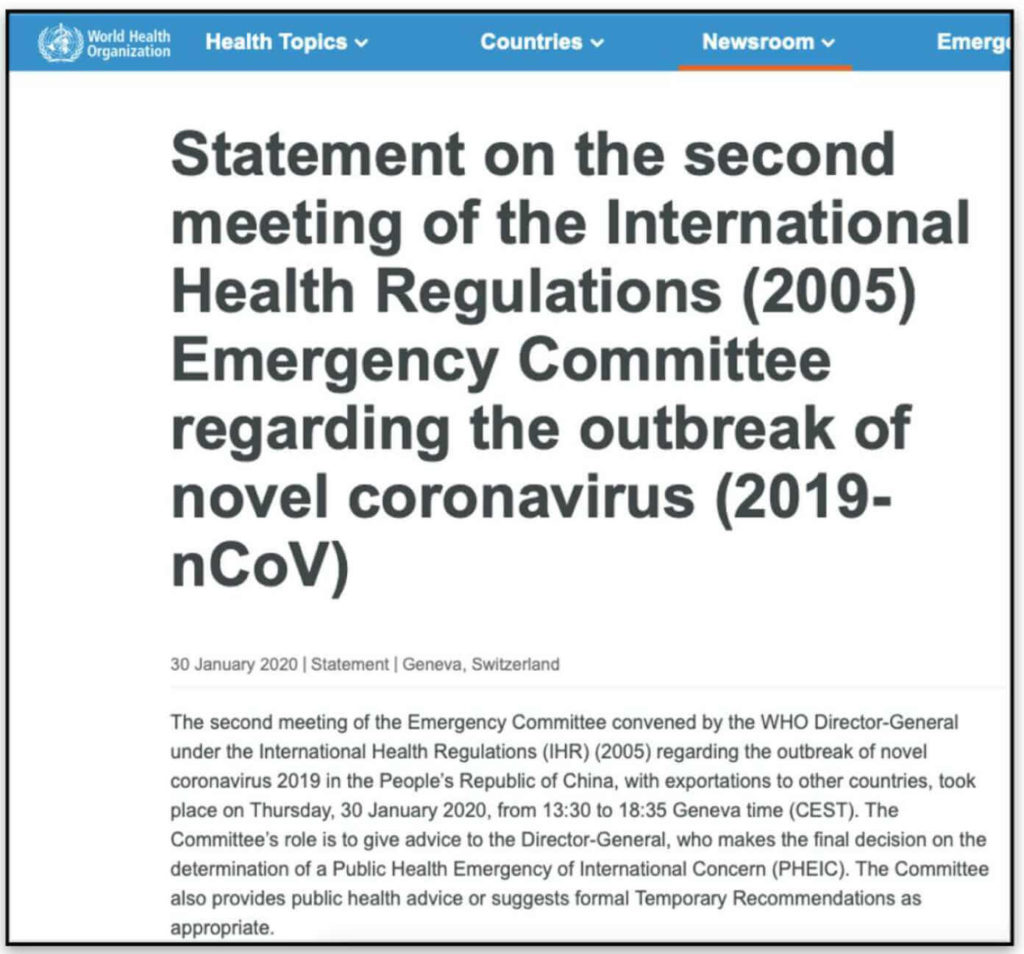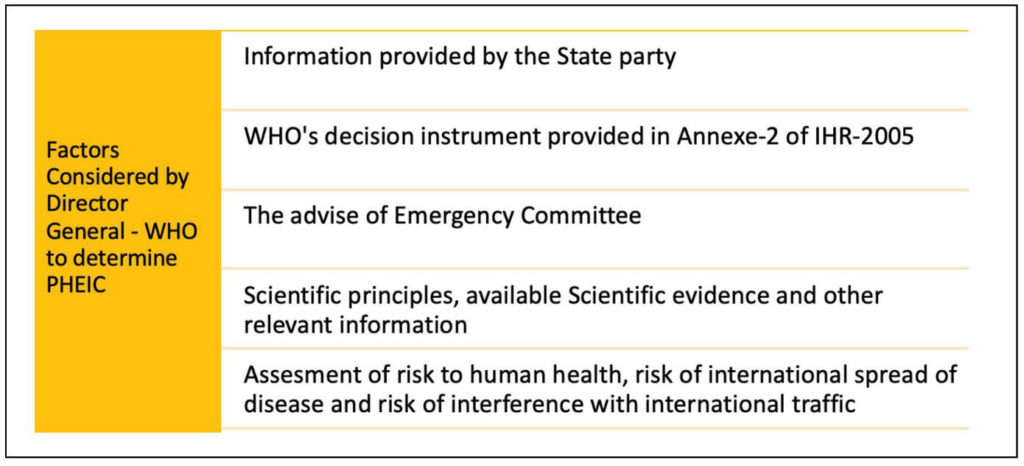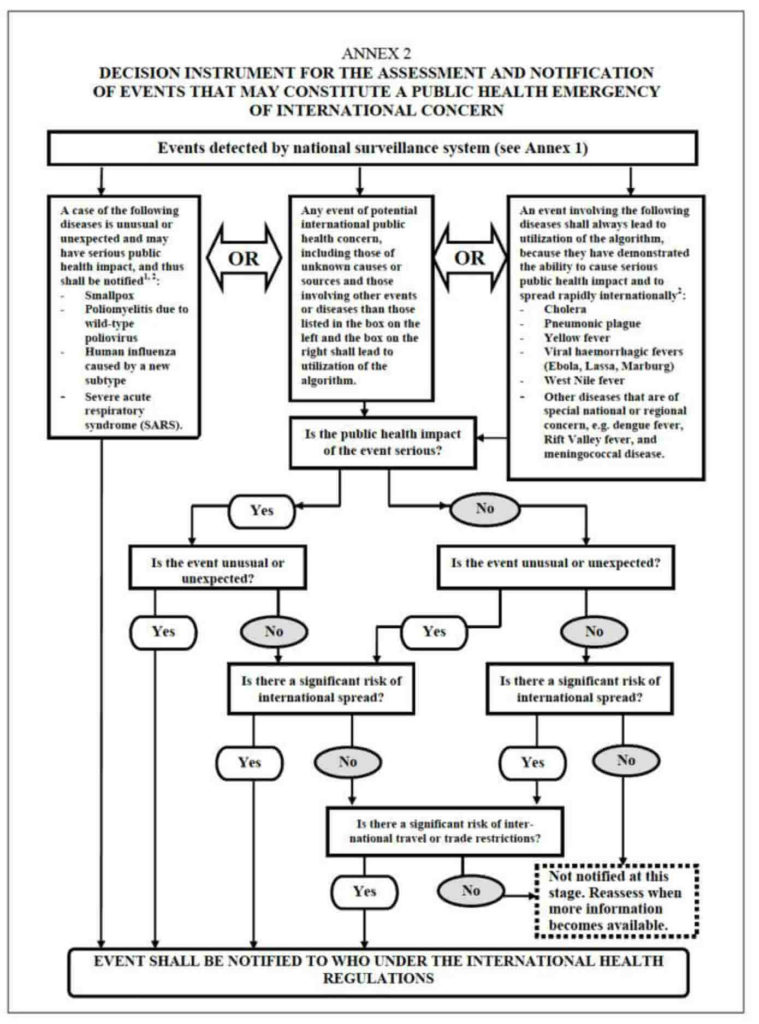Novel Coronavirus Disease (COVID-19) has been declared a ‘public health emergency of international concern (PHEIC)’ by the WHO. But what is PHEIC? How & when is it declared? What are the past instances when PHEIC was declared? Here is a detailed explainer.
Since the Novel Coronavirus Disease (COVID-19) has been first reported on 31 December 2019 in Wuhan (China), it has spread across the globe, with around 110 countries reporting cases of COVID-19 as on 10 March 2020.
China currently accounts for more than 3/4th of the total confirmed cases, followed by Italy, South Korea and Iran. More than 4 thousand deaths are reported around the world due to COVID-19. On 07 March 2020, the World Health Organization (WHO) released a statement that the total number of confirmed cases crossed 1 lakh (i.e. 100 thousand).
Because of the initial rapid spread in China, COVID-19 has been considered as an epidemic. However, with COVID-19 spreading to more than 100 countries, it is now being considered as a pandemic. On 30 January 2020, WHO has taken cognizance of the spread of the disease around the world and the emergency committee convened by the WHO Director-General under International Health Regulations (IHR) (2005) has declared COVID-19 as Public Health Emergency of International Concern (PHEIC).

This was the second meeting of the Emergency Committee. In the first meeting held on 22-23 February 2020, the Committee decided to hold off the declaration of COVID-19 as a PHEIC.
So, what is a PHEIC? When is it declared and who has the authority to declare something as a PHEIC? In this explainer, we explore these questions.
PHEIC is a health emergency of International Nature
International Health Regulations (IHR) were adopted by the Health Assembly in 1969, to prevent the international spread of Diseases. In the aftermath of the emergency due to severe acute respiratory syndrome (SARS) outbreak during the early 2000s, the Health Assembly established an Intergovernmental Working group in 2003 to recommend revisions to the existing IHR. The 58th World Health Assembly adopted IHR (2005) on 23 May 2005.
IHR (2005) is an agreement between 196 countries to work together for global health security. The WHO plays the role of a coordinator. IHR (2005) provides the definition of PHEIC and the procedures to be followed to recognize a health emergency and the necessary action to be taken thereof.
As per IHR’s definition, PHEIC is:
‘An extraordinary event which is determined to constitute a public health risk to other States through the international spread of disease and to potentially require a coordinated international response’.

This definition of PHEIC would imply that the situation is:
- serious, sudden, unusual or unexpected;
- carries implications for public health beyond the affected State’s national border;
- may require immediate international action.
PHEIC is declared by DG-WHO based on multiple consultations
The Director-General of WHO is required to seek the views of an IHR Emergency Committee to determine whether an event can be declared as a PHEIC.
However, prior to the declaration, the Director-General(DG) of WHO needs to have a consultation with the state party in whose boundaries an event is occurring. Like in the case of COVID-19, DG was required to have a consultation with China, since that is where the first instance of the disease was found.
Article 12 of IHR-2005 lays down the process to be followed when an event is initially recognised to be potentially a case of PHEIC. The process is as follows
- Based on the information received from the state party, DG to determine if an event can be considered as a potential PHEIC.
- If the DG considers the event to be PHEIC, a consultation with the respective State party for preliminary determination is necessary
- If both the DG and State party arrive at an agreement on the nature of the event, the DG seeks the view of the Emergency Committee to provide appropriate temporary recommendations.
- Even if there is no consensus achieved, the DG of WHO can proceed with the constitution of an Emergency Committee as per the directions provided in Article 49 of IHR-2005.
The Director-General of WHO takes into consideration the following aspects to determine whether an event constitutes a Public Health Emergency :

DG-WHO is aided by the decision instrument as provided in Annexe-2 of IHR-2005, to evaluate various aspects of the event and to arrive at a decision.

Constitution & Procedure of Emergency Committee under Articles 48 & 49
Articles 48 & 49 of Chapter-II in IHR-2005, lay down the working details of constituting an Emergency Committee (EC).
The EC is established by DG-WHO to provides its views on:
- Whether an event needs to be considered as PHEIC
- To terminate PHEIC
- To propose temporary recommendations along with any modification, extension and termination of the same
The composition of the EC is determined by the DG-WHO and involves:
- Experts to be selected from the IHR Expert Roster
- Experts from other advisory panels of the organization can also be included based on the requirement
- Determination of the duration of membership in view of the event and further occurrences
- The selection is made based on the relevant experience along with principles of equitable geographical representation
- At least one member needs to be an expert belonging to the State party in whose territory the event broke out
Procedure followed by the Emergency Committee
- Meetings of the Emergency Committee are convened by DG-WHO. These meetings can include teleconference, Videoconference or other Electronic communication.
- Agenda is set by the DG. This includes the information received from the respective State parties as well as observations & temporary recommendations made by the DG.
- Emergency Committee is required to elect a Chairperson.
- Summary report of its proceedings & discussions along with advice on the recommendations needs to be provided after every meeting.
- The State Party in whose territory the event arose is invited to present its views to EC.
- The views of the EC are sent to the DG for consideration.
- The DG reviews the views and provides the final determination.
- DG then communicates the determination of the event and the recommendations to the respective States parties. Any future modifications or extensions along with possible termination is duly communicated.
The recommendations provided are temporary in nature and are required to be reviewed every three months post which necessary modifications or extensions are recommended.
In due course, based on the prevailing situation, the State parties can provide a proposal to the DG to terminate PHEIC or any specific temporary recommendations. They can present the same to Emergency Committee who would review and provide their views on termination of PHEIC.
So far 6 PHEIC declarations were made by the WHO
After the adoption of International Health Regulations (IHR)- 2005, by the 196 countries (which includes all the WHO member countries) and laying down the procedures to be following in determining a PHEIC, there have been 6 instances wherein WHO has determined an event to be a PHEIC.
| Sl.No | PHEIC | Details |
|---|---|---|
| 1. | 2009 H1NI pandemic (Swine Flu) | The first declaration of a PHEIC was made in 2009 for H1N1 in 2009. This was declared after one month of first case being identified. By the time of declaration, the case of Swine Flu has been identified in 3 countries. |
| 2. | 2014- Polio | Polio was considered to be nearly eradicated. However, 2014 witnessed a resurgence of Wild Polio, which the Emergency Committee has termed as an ‘Extraordinary Event’. The affected countries by the time of declaration included: Afghanistan, Cameroon, Equatorial Guinea, Ethiopia, Israel, Nigeria, Pakistan & Syrian Arab Republic. |
| 3. | 2014- Outbreak of Ebola | 2014 witnessed another event being declared as PHEIC. By March 2014, there have been cases reported in West African countries of Guinea and Liberia. By May 2019 there were also cases confirmed in Sierra Leone. By August, there have been cases reported in United States & Europe. |
| 4. | 2015-16 Zika Virus Epidemic | On 01 February 2016, the WHO declared its fourth PHEIC. This is a result of the spread of Zika Virus in Latin American and Caribbean countries. It is also the first time that a mosquito borne disease has been declared as a PHEIC. This declaration was lifted during the later part of the year i.e on 18 November 2016. |
| 5. | 2018-19 Kivu Ebola Epidemic | During 2018, there was an Ebola Outbreak in Democratic Republic of Congo. However, in the first two meetings of Emergency Committee, there was recommendation to not declare it as a PHEIC. In spite of the death toll reaching upwards of 1400 by July’2019, it was not considered to be a PHEIC due to the lack of scope of International spread. However, on 14 July 2019, there was a case identified in Goma, Congo which had an international airport. In the fourth meeting, it was recognized a regional threat and PHEIC was declared without any restrictions on trade. |
| 6. | Coronavirus Outbreak | The first meeting of Emergency Committee held back from declaring COVID-19 as PHEIC. However, this was overturned in the second meeting on 30 January 2020. By the time the declaration was made, more than 7,000 confirmed cases were reported across 19 countries. |
More than 4000 deaths reported as on 10 March 2020
As per the dashboard maintained by the WHO, more than 1.1 lakh confirmed cases have been reported across 110 nations as of 10 March 2020. Of these, a total of 80,924 cases reported in China while more than 30 thousand confirmed cases are reported from across the rest of the world.
In China, more than 3100 deaths were caused due to COVID-19 of which 3024 deaths were reported from Hubei province, whose capital is Wuhan, the place where the outbreak was first reported.
South Korea, Italy & Iran have reported more than 7 thousand confirmed cases each. Though South Korea, Italy & Iran reported more than 7 thousand cases each, the death toll has been on the higher side in both Italy & Iran. More than 1000 cases were reported from seven countries including China. Four of these seven countries are from Europe.
Featured Image: Public Health Emergency of International Concern


